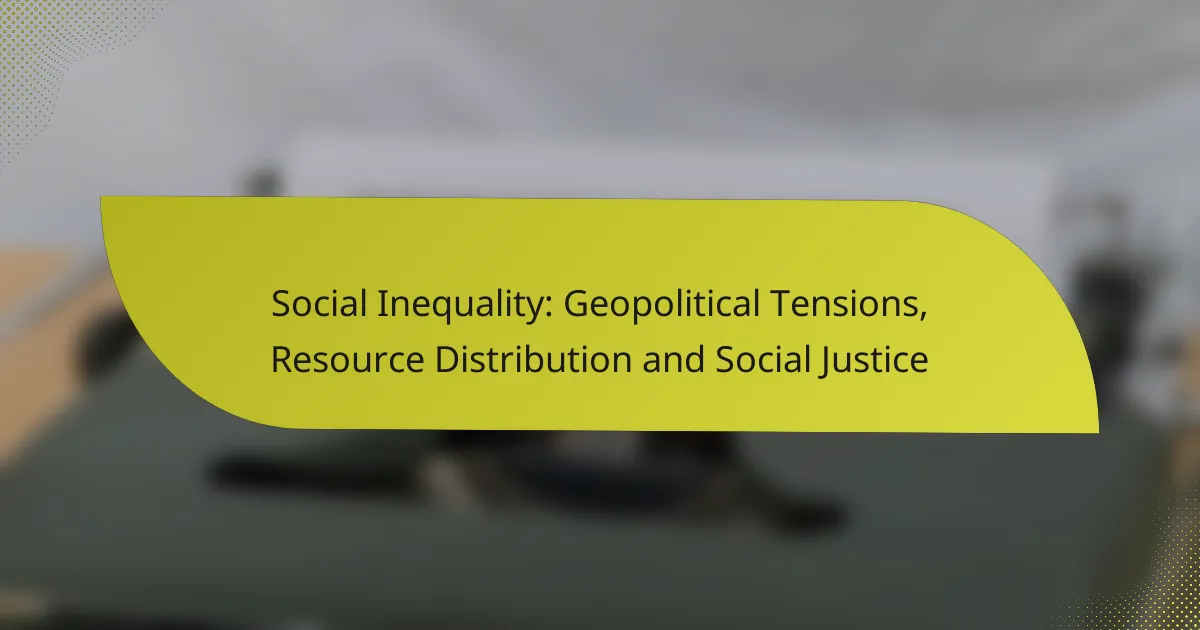Social inequality is a critical driver of geopolitical tensions, as disparities in resource distribution can lead to conflict and unrest. Unequal access to essential services and economic opportunities exacerbates these tensions, prompting nations to take aggressive actions to protect their interests. Addressing these issues through social justice initiatives is vital for fostering equitable access to resources and promoting stability on a global scale.
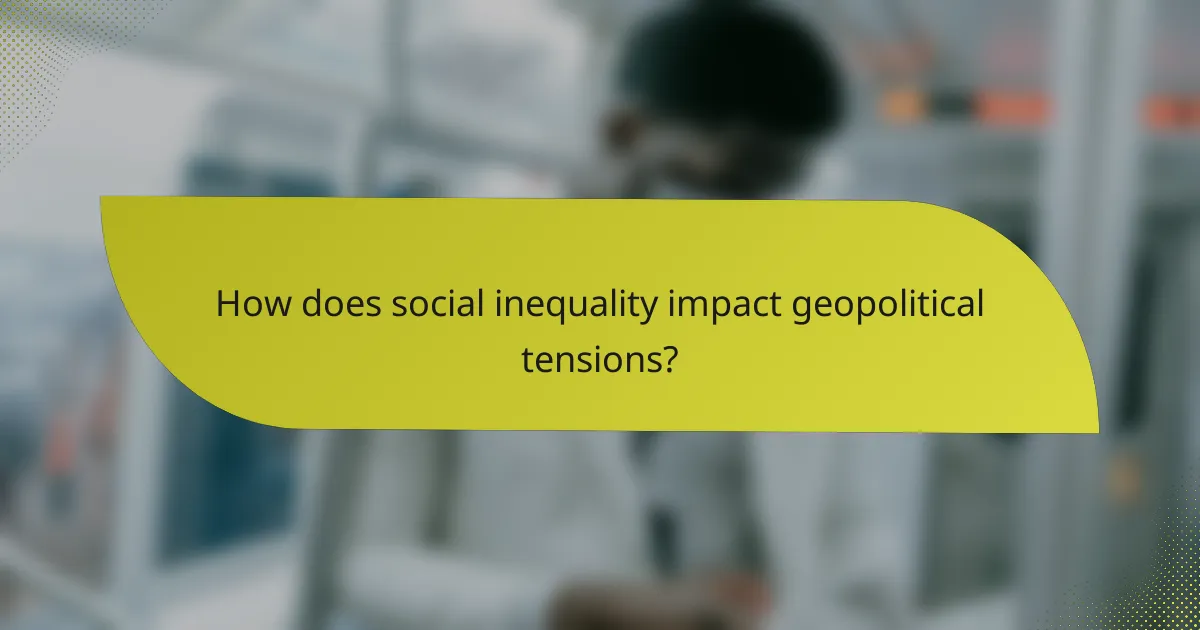
How does social inequality impact geopolitical tensions?
Social inequality significantly heightens geopolitical tensions by creating disparities that lead to conflict, unrest, and diplomatic challenges. When resources and opportunities are unevenly distributed, nations and groups may resort to aggressive measures to secure their interests.
Resource scarcity increases conflicts
Resource scarcity often leads to heightened conflicts, as nations compete for limited supplies of essential commodities like water, oil, and minerals. For instance, regions with dwindling water sources may see increased tensions between neighboring countries, as each seeks to secure access for its population.
In many cases, this competition can escalate into armed conflict, particularly in areas where borders are unclear or disputed. Countries may engage in military actions or form alliances to bolster their resource security, further destabilizing the region.
Economic disparities fuel unrest
Economic disparities within and between nations can lead to significant social unrest, as marginalized groups feel excluded from opportunities and resources. For example, countries with high levels of wealth inequality may experience protests and civil disobedience as citizens demand better living conditions and equitable resource distribution.
These economic tensions can spill over into international relations, causing friction between countries that may be perceived as exploiting or neglecting poorer nations. Addressing these disparities is crucial for maintaining social stability and reducing geopolitical tensions.
Power imbalances affect diplomacy
Power imbalances among nations can severely impact diplomatic relations, as countries with greater resources and influence often dictate terms that disadvantage weaker states. This dynamic can lead to resentment and resistance, complicating negotiations on key issues like trade, security, and environmental policies.
For effective diplomacy, it is essential to recognize and address these imbalances. Engaging in fair negotiations and fostering inclusive partnerships can help mitigate tensions and promote a more stable geopolitical landscape.
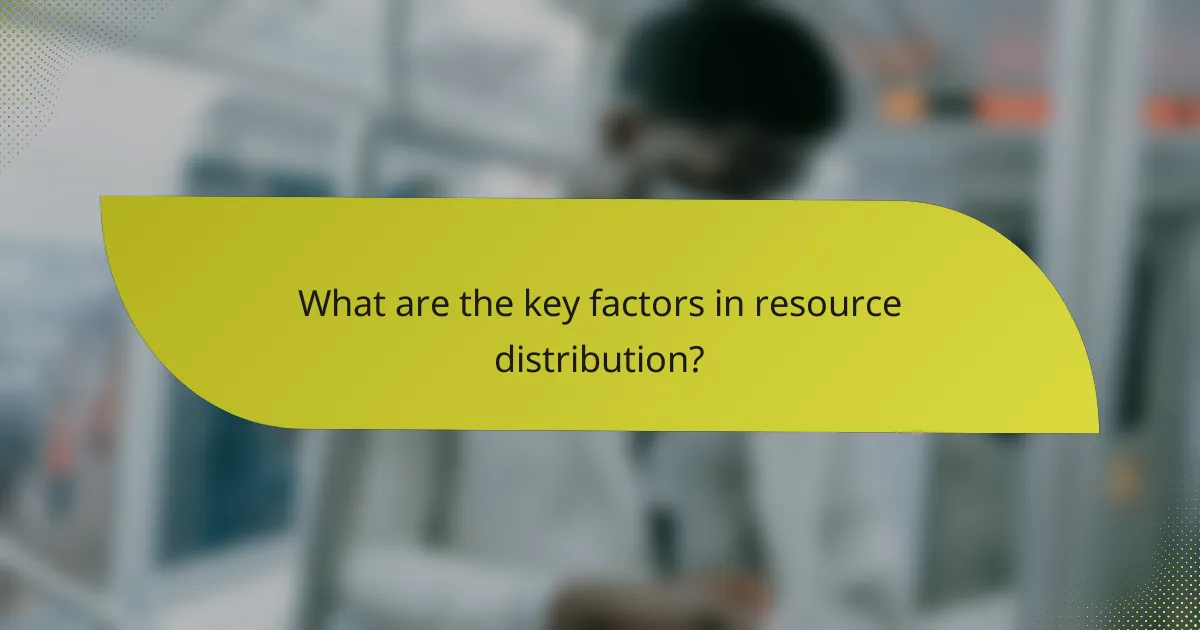
What are the key factors in resource distribution?
The key factors in resource distribution include access to essential services, economic disparities, and government regulations. These elements significantly influence how resources are allocated and can perpetuate social inequality.
Access to education and healthcare
Access to education and healthcare is crucial for equitable resource distribution. Regions with well-funded schools and hospitals tend to have better outcomes, while areas lacking these services often face higher poverty rates and limited opportunities.
For instance, urban centers typically offer more educational institutions and healthcare facilities compared to rural areas. This disparity can lead to a cycle of disadvantage, where individuals in underserved areas struggle to improve their socioeconomic status.
Wealth concentration in urban areas
Wealth concentration in urban areas exacerbates social inequality, as economic resources are often concentrated in cities. This concentration can lead to inflated living costs, making it difficult for lower-income residents to afford housing and basic necessities.
Moreover, urban areas may attract investments and job opportunities, leaving rural regions with fewer economic prospects. This imbalance can create a divide where urban populations thrive while rural communities lag behind.
Government policies on land use
Government policies on land use play a significant role in resource distribution. Zoning laws and land ownership regulations can either promote equitable access to resources or reinforce existing inequalities.
For example, policies that favor large agricultural enterprises over small farmers can lead to displacement and loss of livelihoods for local communities. Ensuring that land use policies are inclusive and equitable is essential for fostering social justice and reducing disparities.

How can social justice initiatives address inequality?
Social justice initiatives can effectively address inequality by promoting fair access to resources and opportunities for marginalized communities. These initiatives often focus on empowering individuals, reforming policies, and fostering international cooperation to create a more equitable society.
Community empowerment programs
Community empowerment programs aim to enhance the capabilities of individuals and groups, enabling them to advocate for their rights and improve their living conditions. These programs often include skills training, education, and leadership development, which help participants gain confidence and influence in their communities.
Examples of successful community empowerment initiatives include local cooperatives that provide economic opportunities and mentorship programs that connect youth with role models. By fostering a sense of ownership and agency, these programs can lead to sustainable improvements in social conditions.
Policy reforms for equitable resource allocation
Policy reforms are essential for ensuring that resources are distributed fairly among different social groups. This can involve revising tax codes, adjusting public spending priorities, and implementing regulations that promote equitable access to services such as healthcare and education.
For instance, progressive taxation can help redistribute wealth, while targeted investments in underserved areas can improve infrastructure and access to essential services. Engaging stakeholders in the policy-making process is crucial to ensure that reforms reflect the needs of affected communities.
International aid and development strategies
International aid and development strategies play a significant role in addressing global social inequalities. These strategies often focus on providing financial assistance, technical support, and capacity-building initiatives to low-income countries, helping them develop sustainable economies.
Effective international aid programs prioritize transparency and accountability, ensuring that funds are used efficiently to benefit those in need. Collaborations between governments, NGOs, and local communities can enhance the impact of aid efforts, leading to long-term improvements in social justice and resource distribution.

What role do international organizations play in social justice?
International organizations are crucial in promoting social justice by establishing frameworks, funding initiatives, and advocating for marginalized communities. They work to address inequalities and ensure equitable resource distribution across nations.
United Nations initiatives
The United Nations (UN) plays a pivotal role in advancing social justice through various initiatives aimed at reducing inequality and promoting human rights. Programs like the Sustainable Development Goals (SDGs) set targets for eradicating poverty and ensuring quality education, gender equality, and reduced inequalities.
Additionally, the UN Human Rights Council monitors compliance with international human rights standards, providing a platform for dialogue and accountability among member states. This helps to highlight issues and mobilize resources to address social injustices globally.
World Bank funding for social programs
The World Bank supports social justice by providing funding for programs that aim to improve living conditions and access to essential services. This includes investments in health, education, and social protection systems, particularly in developing countries.
For instance, the World Bank’s initiatives often focus on vulnerable populations, offering financial assistance that can range from millions to billions of USD, depending on the scale of the project. These funds help implement programs that directly address social inequalities and foster economic development.
Non-governmental organizations’ advocacy
Non-governmental organizations (NGOs) are essential advocates for social justice, often working on the ground to raise awareness and drive change. They engage in grassroots mobilization, lobbying for policy reforms, and providing direct support to affected communities.
Many NGOs focus on specific issues such as women’s rights, racial equality, or environmental justice, employing strategies that include public campaigns, research, and partnerships with local governments. Their efforts can amplify the voices of marginalized groups and influence international policies related to social justice.
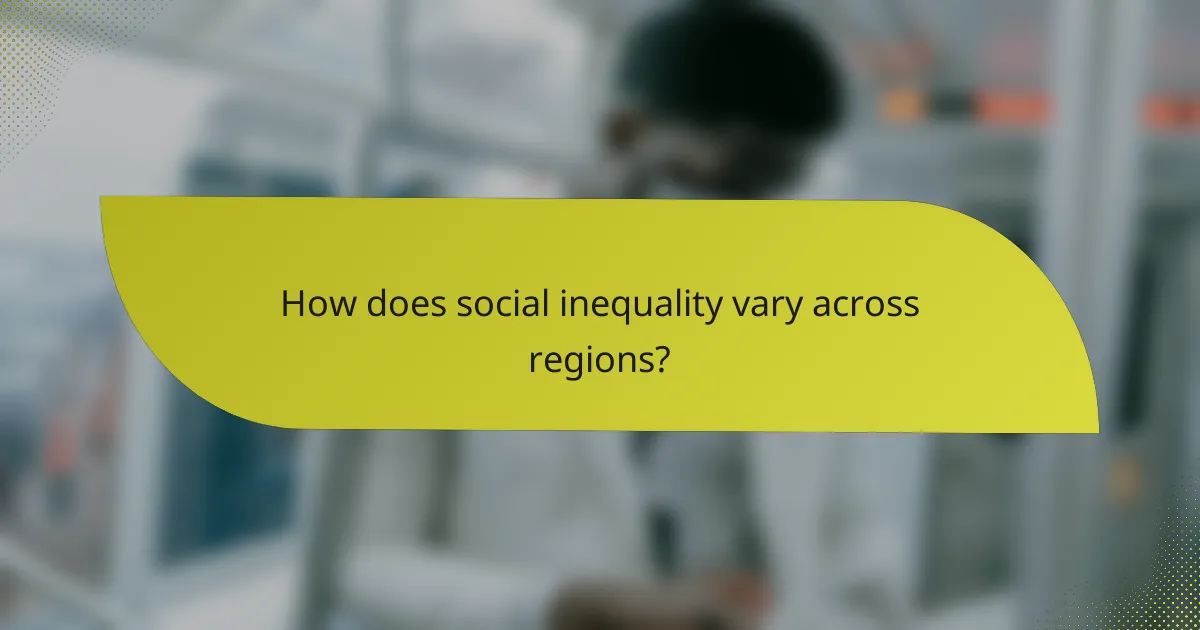
How does social inequality vary across regions?
Social inequality manifests differently across various regions due to factors like economic structures, historical contexts, and governance. These disparities can be seen in income levels, access to essential resources, and social rights, significantly impacting quality of life and opportunities for individuals.
Income disparity in North America
Income disparity in North America is characterized by a significant gap between the wealthy and the poor, with a notable concentration of wealth among the top earners. The top 10% of earners often take home a substantial portion of total income, while many individuals and families struggle to meet basic needs.
Factors contributing to this disparity include educational access, job availability, and systemic issues like discrimination. Addressing income inequality requires targeted policies such as progressive taxation, improved access to education, and support for low-income families.
Access to resources in Sub-Saharan Africa
Access to resources in Sub-Saharan Africa is uneven, with many communities lacking basic necessities such as clean water, healthcare, and education. This inequality is often exacerbated by political instability and economic challenges, limiting opportunities for development.
Efforts to improve resource distribution include international aid, investment in infrastructure, and community-driven initiatives. Sustainable practices and local governance can also play crucial roles in ensuring equitable access to resources.
Gender inequality in South Asia
Gender inequality in South Asia remains a pressing issue, affecting women’s access to education, employment, and healthcare. Cultural norms and legal barriers often restrict women’s rights, leading to disparities in income and social status.
To combat gender inequality, initiatives focusing on education for girls, legal reforms, and economic empowerment programs are essential. Encouraging community involvement and raising awareness can also help shift societal attitudes towards gender equality.
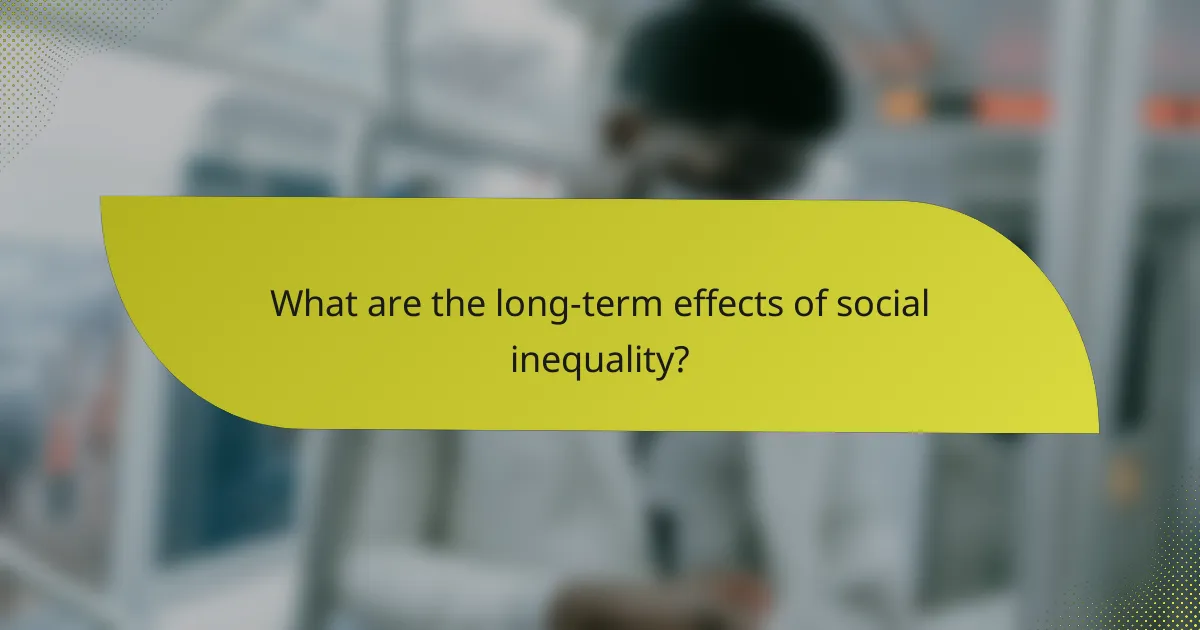
What are the long-term effects of social inequality?
Social inequality can lead to persistent disparities in wealth, access to resources, and opportunities, ultimately hindering societal progress. Over time, these disparities can create significant barriers to economic mobility and social cohesion.
Impact on economic growth
Social inequality negatively affects economic growth by limiting access to education and job opportunities for lower-income populations. When a significant portion of the population cannot participate fully in the economy, overall productivity and innovation suffer.
For example, countries with high levels of inequality often experience slower GDP growth rates compared to more equitable societies. Investing in education and skills training for disadvantaged groups can help mitigate these effects and promote a more inclusive economy.
Social unrest and instability
High levels of social inequality can lead to increased social unrest and instability, as marginalized groups may feel disenfranchised and frustrated. This discontent can manifest in protests, strikes, or even violent conflicts, disrupting communities and economies.
Historically, nations facing stark inequalities have seen significant social movements aimed at addressing these issues. Governments can reduce the risk of unrest by implementing policies that promote social justice, equitable resource distribution, and community engagement.
